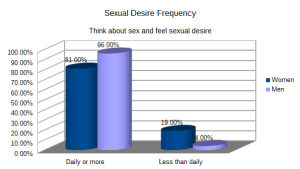Regular Article
Sexual Desire: Factors associated with high sexual desire in women and men.
Dr. Petra Zebroff
Abstract
Objectives:
Low sexual desire is a common complaint for many men and women, especially in long-term relationships. Low desire in women has become of particular focus with low desire reported more in women than men. This survey focused on women (and men) who report high desire to indentify the factors that are associated with high desire.
Method:
32 items measuring arousal preferences were given to 11,048 women and men in an online questionnaire linked from articles describing sexual arousal on popular content websites.
The majority of participants (n= 2,264 men, n=8,752 women, n=32 other) were heterosexual, under the age of 50 with the youngest group 18 – 34 most strongly represented (65.4%), and in a relationship (71.8%), with 42.5% living together.
They were asked to define their frequency of desire in the last 4 weeks, their desire for solo sex and partnered sex, sexual satisfaction, sexual function and arousal preferences.
Results:
The majority of participants reported feeling high desire (W=81%, M=96%) as defined as thinking about sex or feeling sexual desire at least one time per day. The low desire group, defined almost never or never thinking about sex or feeling sexual desire was 2.3% for women and 0.7% for men.
Eleven factors were identified as significantly related to high desire in women. Five factors positively associated with high desire in women were: 1. Using fantasy (p<.001); 2. Not living together (p<.001); 3. Ability to laugh in sexual context (p<.001); Drinking alcohol (2 glasses+/day) (p=.005); Age under 50 (p=.019).
The factors negatively associated with high desire in women: 1. Not being able to talk partner about sex (p<.0001); 2. Discomfort with masturbation (p<.001); 3. Partner’s low sexual skill (p<.001); 4. Belief that sex is only correct with love (p<.001); and 5. Worrying how body looks during sex (p=.002).
Five factors were associated with high desire in men. Positively associated factors: 1. Using fantasy (p<.001); 2. Using laughter in a sexual context (p<.001). Negative associations were: 1. Feeling your partner does not have your best interests (p=.032); 2. Not being abel to talk to partner about sex (p=.003); and 3. Belief that sex is only correct with love (p=.008).
When relationship factors were included, ‘high relationship satisfaction’ was positively associated for both genders, while ‘high use of fantasy’ stayed as the most significant factor.
Discussion:
Sexual desire is complex, with cognitive, social and physical factors weighing in to the result of high or low desire. Several factors were found that were associated with high sexual desire in men and women. The ability to fantasize had strong influence in both men and women, trumping relationship satisfaction and belief systems. The ability to use fantasy requires more study, especially for those men and women with low desire.
There were significantly fewer factors associated with men’s desire than women’s desire, consistent with the few that men’s desire is more straightforward and less affected by other factors than women’s desire.
————————————————————————————————————
References:
